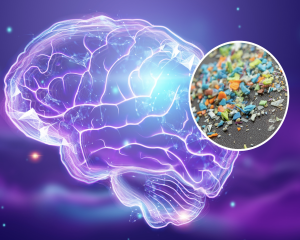This study published today confirms the presence of MNPs in the brain—and at shocking levels.
今天發(fā)表的這項研究證實了納米塑料在大腦中的存在,而且含量驚人。
The study examined 52 human brain samples from 2016 and 2024, all taken from the frontal cortex, the part of the brain responsible for judgment, decision making, and muscle movement.
研究分析了2016年和2024年的52個人類大腦樣本,所有樣本均取自大腦額葉皮層,這是負責判斷、決策和肌肉運動的部分。
The researchers also looked at liver and kidney samples from the same bodies, analyzing all tissue using microscope imaging and molecular analysis to identify the chemical composition.
研究人員還檢查了同一批樣本的肝臟和腎臟,通過顯微鏡成像和分子分析來確定組織的化學成分。
Brain and liver samples from 2024 had significantly higher concentrations of MNPs compared with those from 2016.
與2016年相比,2024年的大腦和肝臟樣本中MNPs的濃度顯著增加。
The total mass of plastics in the brains studied increased by about 50 percent between 2016 and 2024, and the researchers suggest drastically increasing concentrations of MNPs in our homes, air, and water could be to blame.
研究發(fā)現(xiàn),2016年至2024年間,大腦中塑料的總質量增加了約50%,研究人員認為,這可能是因為我們家中、空氣和水中的納米塑料濃度急劇上升。
"I'm quite shocked by the amount of microplastics they find," says Emma Kasteel, neurotoxicologist at Utrecht University in the Netherlands. "It was a lot higher than I would have expected."
荷蘭烏得勒支大學的神經毒理學家艾瑪·卡斯特爾表示:“我對他們發(fā)現(xiàn)的微塑料數(shù)量感到震驚,這比我預期的要高得多。”
Growing levels of microplastics in the environment are reflected in the new findings, says Kasteel, with more exposure likely the cause of more plastic particles in the organs.
卡斯特爾指出,環(huán)境中的微塑料水平不斷上升,這在新研究中得到了反映,更多的暴露可能是器官中塑料顆粒增加的原因。

The brain samples overall had 7 to 30 times more MNPs compared with liver and kidney samples.
與肝臟和腎臟樣本相比,大腦樣本中的納米塑料含量高出7到30倍。
Particles found in the brain were mostly tiny shards or flakes of polyethylene, one of the most common plastics in the world, often used in packaging.
大腦中發(fā)現(xiàn)的顆粒主要是聚乙烯的微小碎片,聚乙烯是世界上最常見的塑料之一,常用于包裝。
It makes sense that MNPs accumulate more in the brain compared to other organs, says Kasteel.
卡斯特爾解釋說,納米塑料在大腦中的積累比其他器官更多是合理的。
Inhalation through the nose to what's called the olfactory bulb, the part of the brain that processes smell, gives MNPs in the air a more direct route to the brain than to other organs.
通過鼻子吸入的空氣會進入大腦的嗅球,這是處理氣味的部位,這使得空氣中的MNPs比其他器官更容易直接進入大腦。
Campen points out the age of the person was not associated with the amount of plastic in the organs, meaning the body does clear the plastic in some way -- if not, older individuals' organs would just continue to accumulate more and more plastic over the years.
坎彭指出,器官中的塑料含量與年齡無關,這意味著身體會以某種方式清除塑料--否則,老年人的器官會隨著時間的推移積累越來越多的塑料。
Another notable finding was that MNP levels were about three to five times higher in 12 brains from people who had been diagnosed with dementia.
另一個值得注意的發(fā)現(xiàn)是,在被診斷為癡呆癥的12個大腦中,納米塑料水平高出3到5倍。
The researchers clarify this does not necessarily mean MNPs cause dementia, but it shows an association that should be studied further.
研究人員澄清說,這并不一定意味著納米塑料會導致癡呆癥,但它表明了兩者之間的關聯(lián),值得進一步研究。
Kasteel says the connection is likely because people with dementia tend to have blood-brain barriers that don't function as well as a filter as in healthy people, meaning the high concentration of MNPs could be a consequence of dementia rather than a cause.
卡斯特爾認為,這種關聯(lián)可能是因為癡呆癥患者的血腦屏障功能不如健康人那樣有效,這意味著高濃度的納米塑料可能是癡呆癥的結果,而不是原因。



